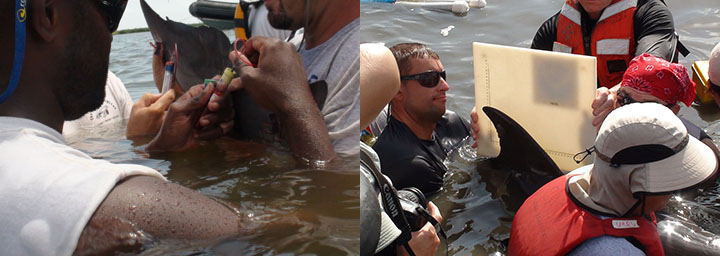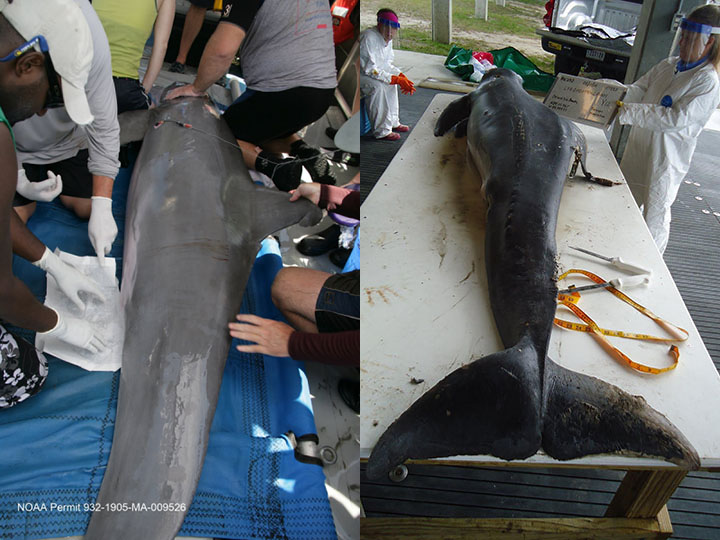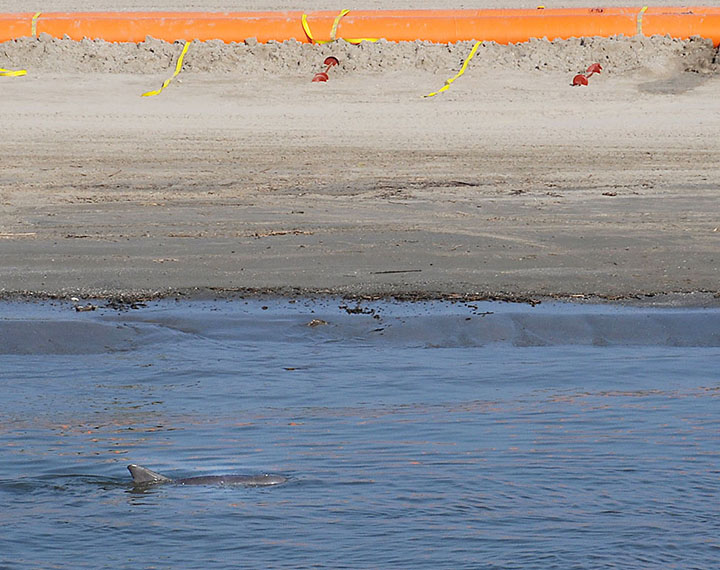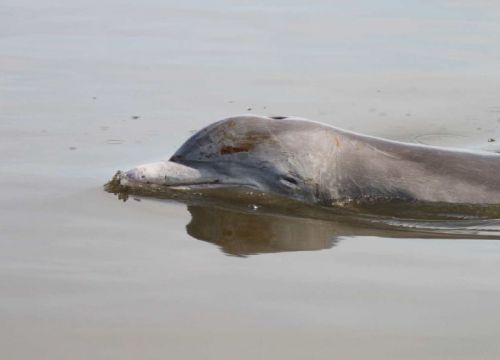In the Wake of the Deepwater Horizon Oil Spill, Gulf Dolphins Found Sick and Dying in Larger Numbers Than Ever Before
The Deepwater Horizon Oil Spill: Five Years Later
This is the third in a series of stories over the coming weeks looking at various topics related to the response, the Natural Resource Damage Assessment science, restoration efforts, and the future of the Gulf of Mexico.
APRIL 3, 2015 — Dolphins washing up dead in the northern Gulf of Mexico are not an uncommon phenomenon.
What has been uncommon, however, is how many more dead bottlenose dolphins have been observed in coastal waters affected by the Deepwater Horizon oil spill in the five years since. In addition to these alarmingly high numbers, researchers have found that bottlenose dolphins living in those areas are in poor health, plagued by chronic lung disease and failed pregnancies.
Independent and government scientists have undertaken a number of studies to understand how this oil spill may have affected dolphins, observed swimming through oil and with oil on their skin, living in waters along the Gulf Coast. These ongoing efforts have included examining and analyzing dead dolphins stranded on beaches, using photography to monitor living populations, and performing comprehensive health examinations on live dolphins in areas both affected and unaffected by Deepwater Horizon oil.
The results of these rigorous studies, which recently have been and continue to be published in peer-reviewed scientific journals, show that, in the wake of the 2010 Deepwater Horizon oil spill and in the areas hardest hit, the dolphin populations of the northern Gulf of Mexico have been in crisis.
Troubled Waters

Due south of New Orleans, Louisiana, and northwest of the Macondo oil well that gushed millions of barrels of oil for 87 days, lies Barataria Bay. Its boundaries are a complex tangle of inlets and islands, part of the marshy delta where the Mississippi River meets the Gulf of Mexico and year-round home to a group of bottlenose dolphins.
During the Deepwater Horizon oil spill, this area was one of the most heavily oiled along the coast. Beginning the summer after the spill, record numbers of dolphins started stranding, or coming ashore, often dead, in Barataria Bay (Venn-Watson et al. 2015). One period of extremely high numbers of dolphin deaths in Barataria Bay, part of the ongoing, largest and longest-lasting dolphin die-off recorded in the Gulf of Mexico, persisted from August 2010 until December 2011.
In the summer of 2011, researchers also measured the health of dolphins living in Barataria Bay, comparing them with dolphins in Sarasota Bay, Florida, an area untouched by the Deepwater Horizon oil spill.
Differences between the two populations were stark.
Many Barataria Bay dolphins were in very poor health, some of them significantly underweight and five times more likely to have moderate-to-severe lung disease. Notably, the dolphins of Barataria Bay also were suffering from disturbingly low levels of key stress hormones which could prevent their bodies from responding appropriately to stressful situations. (Schwacke et al. 2014)
"The magnitude of the health effects that we saw was surprising," said NOAA scientist Dr. Lori Schwacke, who helped lead this study. "We've done these health assessments in a number of locations across the southeast U.S. coast and we've never seen animals that were in this poor of condition."
The types of illnesses observed in live Barataria Bay dolphins, which had sufficient opportunities to inhale or ingest oil following the 2010 spill, match those found in people and other animals also exposed to oil. In addition, the levels of other pollutants, such as DDT and PCBs, which previously have been linked to adverse health effects in marine mammals, were much lower in Barataria Bay dolphins than those from the west coast of Florida.
Dead in the Water
Based on findings from the 2011 study, the outlook for dolphins living in one of the most heavily oiled areas of the Gulf was grim. Nearly 20 percent of the Barataria Bay dolphins examined that year were not expected to live, and in fact, the carcass of one of them was found dead less than six months later (Schwacke et al. 2014). Scientists have continued to monitor the dolphins of Barataria Bay to document their health, survival, and success giving birth.

Considering these health conditions, it should come as little surprise that record high numbers of dolphins have been dying along the coasts of Louisiana (especially Barataria Bay), Alabama, and Mississippi. This ongoing, higher-than-usual marine mammal die-off, known as an unusual mortality event, has lasted over four years and claimed more than a thousand marine mammals, mostly bottlenose dolphins. For comparison, the next longest lasting Gulf die-off (in 2005–2006) ended after roughly a year and a half (Litz et al. 2014 [PDF]).
Researchers studying this exceptionally long unusual mortality event, which began in February 2010, identified within it multiple distinct groupings of dolphin deaths. All but one of them occurred after the Deepwater Horizon oil spill, which released oil from April to July 2010, and corresponded with areas exposed heavily to the oil, particularly Barataria Bay (Venn-Watson et al. 2015).
In early 2011, the spring following the oil spill, Mississippi and Alabama saw a marked increase in dead dolphin calves, which either died late in pregnancy or soon after birth, and which would have been exposed to oil as they were developing.
The Gulf coasts of Florida and Texas, which received comparatively little oiling from the Deepwater Horizon spill, did not see the same significant annual increases in dead dolphins as the other Gulf states (Venn-Watson et al. 2015). For example, Louisiana sees an average of 20 dead whales and dolphins wash up each year, but in 2011 alone, this state recorded 163 (Litz et al. 2014 [PDF]).
The one grouping of dolphin deaths starting before the spill, from March to May 2010, took place in Louisiana's Lake Pontchartrain (a brackish lagoon) and western Mississippi. Researchers observed both low salinity levels in this lake and tell-tale skin lesions thought to be associated with low salinity levels on this group of dolphins. This combined evidence supports that short-term, freshwater exposure in addition to cold weather early in 2010 may have been key contributors to those dolphin deaths prior to the Deepwater Horizon spill.
Legacy of a Spill?

In the past, large dolphin die-offs in the Gulf of Mexico could usually be tied to short-lived, discrete events, such as morbillivirus and marine biotoxins (resulting from harmful algal blooms). While studies are ongoing, the current evidence does not support that these past causes are responsible for the current increases in dolphin deaths in the northern Gulf since 2010 (Litz et al. 2014).
However, the Deepwater Horizon oil spill—its timing, location, and nature—offers the strongest evidence for explaining why so many dolphins have been sick and dying in the Gulf since 2010. Ongoing studies are assessing disease among dolphins that have died and potential changes in dolphin health over the years since the spill.
As is the case for deep-sea corals, the full effects of this oil spill on the long-lived and slow-to-mature bottlenose dolphins and other dolphins and whales in the Gulf may not appear for years. Find more information related to dolphin health in the Gulf of Mexico on NOAA's Unusual Mortality Event and Gulf Spill Restoration websites.
By Ashley Braun, NOAA's Office of Response and Restoration Web Editor.
 An official website of the United States government.
An official website of the United States government. 
